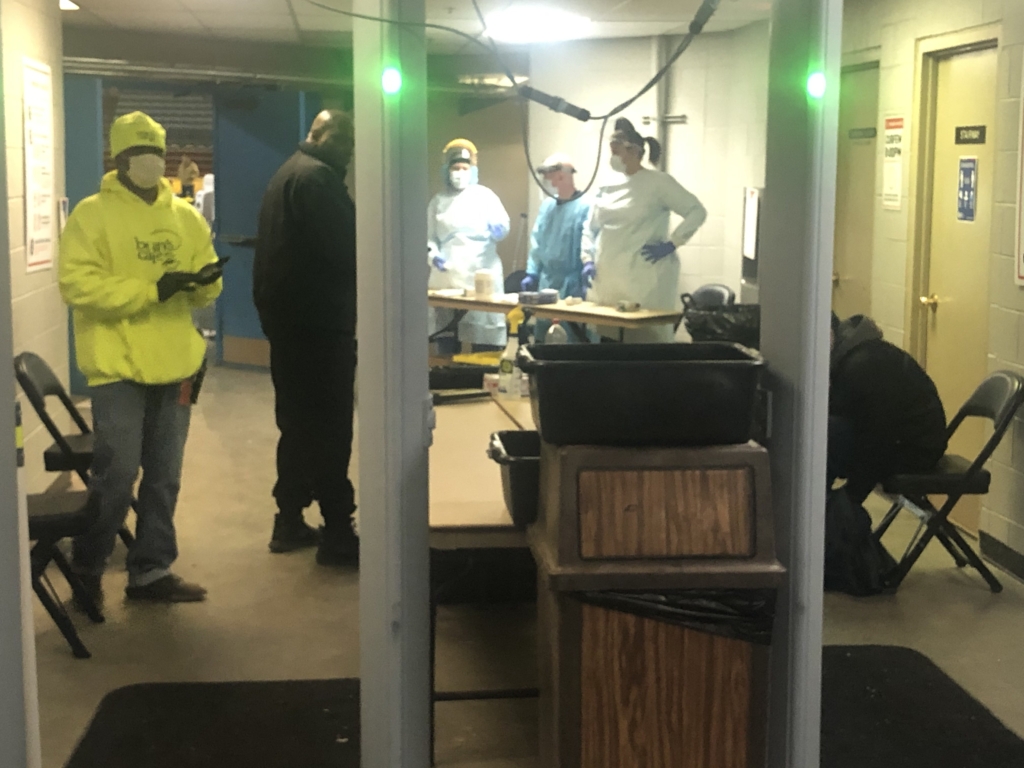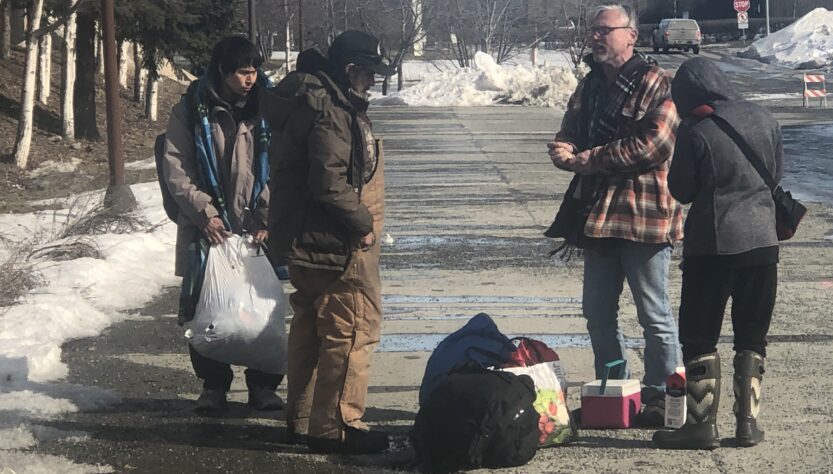Story and photos by Bobby Ellis
We tend to think of homeless people as those individuals we see on street corners, but the nearly 2,000 people who make up Alaska’s homeless range from family units to military veterans to young adults.
The number of homeless in the state has been trending up slightly, in part because the state’s economy has been weak. Next came a decrease in state support for social services that help this vulnerable population. Furthermore, now agencies that house and feed the homeless are likely to confront the impact of job losses related to COVID-19.
The Anchorage Coalition to End Homelessness reports that the number of people needing assistance has ticked up. In winter 2019, 3,339 people in Anchorage needed services such as emergency shelter or public assistance to help them keep a roof over their heads. Of that number, 16% were children.
Without employment, people cannot support their families or themselves. The homeless have most often survived by depending on well-wishers to give them money or by eating out of trash cans because they cannot afford food.The homeless are called homeless for a reason; they lack a home and everything inside. In Alaska, extreme weather can make homelessness a death sentence. Young people and seniors are among the most vulnerable. The municipality’s recreational trails and parks are an option for camping out rather than congregating on the streets.
Backpacking or car camping (also known as dispersed camping)
is permitted on state forest land if your site is located more than one mile from a state forest campground. It is free of charge. Most of the camps that have emerged on the roads and sidewalks are not within the laws for camping guidelines.
However, because of a lack of alternatives, homeless people put up their tents in the city’s green spaces. Since the activity is illegal, the police conduct regular checkups to look for homeless people camping in the area. The municipal ordinance requires that police give individuals ten days to clear from the area.

The Municipality of Anchorage has been working on homelessness issues for about two decades. Furthermore, despite a public perception that camps in parks and along trails have gotten more numerous, they are decreasing.
In the last few years, the city has improved its process for clearing out homeless camps. In summer 2018, the city counted the total homeless population at 1,064, 240 than in 2017. They also cleared out more camps — almost 369 compared to 132 in summer 2017, according to an Anchorage Daily News story published in July 2019.
The city has homeless shelters, such as The Anchorage Gospel Rescue Mission. This shelter serves food and doubles as a homeless shelter to individuals who can pass a breathalyzer exam before entry.
The Brother Francis Shelter, a program of Catholic Social Services, is designated as an emergency shelter. “We admit about 240 individuals per day, said David Rittenberg, the program director. “Most of our shelter guests want to transition out of homelessness, and we offer our guests access to a variety of different services and supportive programs to help them transition out of homelessness. Although individuals are working, countless people are closer to homelessness than having millions. Those who are panhandling are not the only people struggling.”
Covenant House Alaska is designated for youth ages 13 to 24 that are at risk of homelessness and need a safe place to stay and get help. All services are free of charge and have 60 beds, behavioral health counseling, and a clinic.
Josh Louwerse, the youth engagement center director, said, “Our goal is to get clients into stable housing. We offer a 30-day voucher that will pay for the first month for an apartment for those who find a place to live but are unable to pay.” Another essential service Covenant House provides is a Title One school Program with GED assistance.
“We are working to end homelessness and helping our youth community have a place to stay that is short and brief, shelters might be a necessary stopgap for many people,” Louwerse said, “but not much more than that.”
Homeless shelters also have other factors associated with living in these facilities.
Wilford F., a resident of a local shelter, said, “I once stayed at the shelter, and my impression is that a lot of homeless people enjoy the freedom of living on the streets whereas, in a homeless shelter, there are stringent rules. We are told when to go to bed, when to wake up and when to eat. He added that to stay in a shelter, residents must stay sober and drug-free, and many people are too addicted to adhere to such rules.”
Jacqueline H. said, “many homeless shelters are rife with bed bugs, lice, fleas, and scabies. Once infested, the shelters cannot get rid of them because someone else who is homeless will come in and re-infest the whole place all over again.”
Those who are turned away are often wandering the streets until daylight hours or rotating from hospitals and jails in a bid to find a place to stay. In September 2019, 24-hour shelters had to stay closed during the daytime, thus putting people out, including mothers and their children, as early as 8 a.m., with the shelter managers being forced to make difficult
decisions about who could stay and who had to leave.
Nonprofit organizations and advocates have tried to deal with the homelessness crisis. In simple terms, more money is needed for a range of services — emergency shelters, transitional housing, legal aid for people working through eviction, mental health services, substance abuse counseling are some of the main ones. However, with state budget cuts, it is
a concern about how they will be able to offer the services and keep the homeless safe and warm.
On a typical night in the United States, half a million persons are homeless. Out of this population, a quarter is children, and 15% of these people are chronically homeless, meaning they have not had a permanent place to live in a long time. This spring, homeless people — considered vulnerable because of health and age issues — moved to the Sullivan Arena and the Ben Boeke Indoor Ice Arena to increase social distancing during the COVID-19 pandemic. It is just another moment in a long effort to try to wage war with few weapons at our disposal.
Shelters and other help
Gospel Rescue Mission, 2823 Tudor Road
Clare House, 4110 Spenard Road, for women with children, pregnant women
Salvation Army McKinnell House, 1712 A St.
Church of the Nations, 810 Ninth Ave.
Brother Francis, 1021 E. Third Ave.
Food distribution centers:
Bean’s Café, (temporarily housed at Sullivan Arena/Ben Boeke Ice Arena)
Downtown Hope Center, 240 E. Third Ave.
Salvation Army McKinnell House, 1712 A St.
Women, Infants & Children Nutrition (WIC), Alaska Department of Health, 825 L St., Suite 215
HousingAssistanceOnline.com provides a list of nonprofit housing assistance resources.

